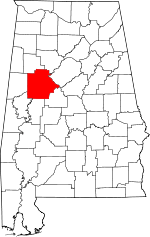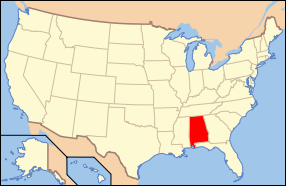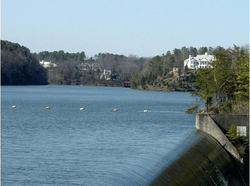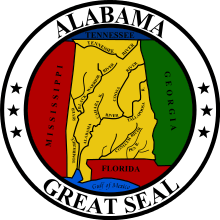Tuscaloosa County, Alabama
| Tuscaloosa County, Alabama | |
|---|---|
 County Courthouse in Tuscaloosa | |
 Location in the U.S. state of Alabama | |
 Alabama's location in the U.S. | |
| Founded | February 6, 1818[1] |
| Named for | Tuskaloosa |
| Seat | Tuscaloosa |
| Largest city | Tuscaloosa |
| Area | |
| • Total | 1,351 sq mi (3,499 km2) |
| • Land | 1,322 sq mi (3,424 km2) |
| • Water | 30 sq mi (78 km2), 2.2% |
| Population (est.) | |
| • (2015) | 203,976 |
| • Density | 153/sq mi (59/km²) |
| Congressional districts | 4th, 7th |
| Time zone | Central: UTC-6/-5 |
| Website |
www |
|
Footnotes:
| |
Tuscaloosa County is a county in the U.S. state of Alabama.[1] As of the 2010 census, its population was 194,656.[2] Its county seat and largest city is Tuscaloosa, the former state capital from 1826 to 1845.[1][3] The county is named in honor of Tuskaloosa, a paramount chief of the Mississippian culture, considered ancestors of the Choctaw in the region.[1][4]
Tuscaloosa County is included in the Tuscaloosa, AL Metropolitan Statistical Area. The county is the home of the University of Alabama and Stillman College.
History
Tuscaloosa County was established on February 6, 1818. During the antebellum years, the principal crop was cotton, cultivated and processed by African-American slaves. By 1860, shortly before the state seceded from the Union, the county had a total of 12,971 whites, 84 "free" African Americans and 10,145 slaves; the latter comprised 43.7 percent of the total population.[5] The war brought significant changes, including migration out of the county by African Americans. "By the 1870 census, the white population of Tuscaloosa County had decreased about 9% to 11,787, while the African American population decreased about 19% to 8,294."[5] Some freedmen moved to nearby counties and larger cities for more opportunities and to join with other freedmen in communities less subject to white supervision.[5]
Following passage by Alabama of the 1901 constitution that disenfrachised most African Americans, followed by the state legislature passing laws to impose Jim Crow, and problems of continued violence by lynchings, many African Americans left Alabama in two waves of the Great Migration. They went to Northern and Midwestern industrial cities. Their mass departure is reflected in lower rates of county population growth from 1910 to 1930, and from 1950 to 1970. (see Census Table below.)
As a result of these changes and growth by the white population, "by 1960, 100 years later, the County was listed as having 77,719 whites, about six times more than 100 years earlier, while the 1960 total of 31,303 "Negroes" was about three times more than what the colored population had been 100 years before."[5] They represented 28.7% of the population and were still disenfranchised. After passage of the federal Voting Rights Act of 1965, African Americans gained their ability to vote and participate in the political system. In 2015, one of the four elected County Commissioners is African American. Since the late 20th century, white conservatives in Alabama and other southern states have increasingly supported Republican Party candidates. African Americans have generally supported the Democratic Party, in a realignment of politics in the state since the period after Reconstruction.
In the 21st century, the principal agricultural products have included hay, corn, cotton, soybeans, wheat and snapdragons.[1] Major companies in the county have included JVC, Mercedes-Benz U.S. International, Uniroyal-Goodrich, and Phifer Inc.[1]
Tornado incidents
1998
On April 8, 1998, an F3 tornado struck northeast of Tuscaloosa. This windstorm injured two people and damaged five homes including mobile homes. It rotated seventeen miles (27 km) from Holman to north of Northport. Thirty-seven homes were also in destruction. Moments later, an F5 tornado struck northeastern Tuscaloosa near the Black Warrior River before entering western Jefferson County.
2011
On April 27, 2011, Tuscaloosa was hit by a half-mile (800 m) wide tornado, which was part of the April 25–28, 2011 tornado outbreak in the region. It resulted in at least 44 deaths, over 1000 injuries, and massive devastation.[6][7] Officials at DCH Hospital (alone) in Tuscaloosa reported treating more than 1000 injured people in the first several days of the tornado aftermath.[8] Initially, officials said that "more than 50 children arrived alone" at the hospital, raising questions about the possible loss of their parents, and 30 of these children were transferred to pediatric trauma wards, indicating serious injuries.[8] Mayor Walter Maddox was quoted saying that "We have neighborhoods that have been basically removed from the map."[9]
On April 29, President Obama, upon touring the tornado damage in Tuscaloosa, said "I have never seen devastation like this".[10]
Geography
According to the U.S. Census Bureau, the county has a total area of 1,351 square miles (3,500 km2), of which 1,322 square miles (3,420 km2) is land and 30 square miles (78 km2) (2.2%) is water.[11] It is the second-largest county in Alabama by land area and third-largest by total area. It is located in the west central part of the state, in the region commonly known as West Alabama. The county straddles the boundary between the Appalachian Highlands and the Gulf Coastal Plain and consequently boasts a diverse geography.
Adjacent counties
- Walker County (northeast)
- Jefferson County (east)
- Bibb County (southeast)
- Hale County (south)
- Greene County (southwest)
- Pickens County (west)
- Fayette County (northwest)
National protected area
- Talladega National Forest (part)
Demographics
| Historical population | |||
|---|---|---|---|
| Census | Pop. | %± | |
| 1820 | 8,229 | — | |
| 1830 | 13,646 | 65.8% | |
| 1840 | 16,583 | 21.5% | |
| 1850 | 18,056 | 8.9% | |
| 1860 | 23,200 | 28.5% | |
| 1870 | 20,081 | −13.4% | |
| 1880 | 24,957 | 24.3% | |
| 1890 | 30,352 | 21.6% | |
| 1900 | 36,147 | 19.1% | |
| 1910 | 47,559 | 31.6% | |
| 1920 | 53,680 | 12.9% | |
| 1930 | 64,153 | 19.5% | |
| 1940 | 76,036 | 18.5% | |
| 1950 | 94,092 | 23.7% | |
| 1960 | 109,047 | 15.9% | |
| 1970 | 116,029 | 6.4% | |
| 1980 | 137,541 | 18.5% | |
| 1990 | 150,522 | 9.4% | |
| 2000 | 164,875 | 9.5% | |
| 2010 | 194,656 | 18.1% | |
| Est. 2015 | 203,976 | [12] | 4.8% |
| U.S. Decennial Census[13] 1790–1960[14] 1900–1990[15] 1990–2000[16] 2010–2015[2] | |||
As of the census of 2000, there were 164,875 people, 64,517 households, and 41,677 families residing in the county. The population density was 124 per square mile (48 persons/km2). The population core of the county lies in Tuscaloosa-Northport conurbation (including Coaling, Coker, and Holt CDP). The combined 2000 Census population of this area (not including their undesignated suburban census areas) is 103,367, accounting for 62.7% of the county in population, while only accounting for 6.9% in area. Consequently, the population density of the central population core is 1,137 persons per square mile (439 persons/km2), while the density of the county outside the central population core is only 44 persons per square mile (17 persons/km2).
There were 71,429 housing units at an average density of 54 per square mile (21/km2). The racial makeup of the county was 68.12% White, 29.31% Black or African American, 0.23% Native American, 0.92% Asian, 0.03% Pacific Islander, 0.56% from other races, and 0.82% from two or more races. Nearly 1.29% of the population were Hispanic or Latino of any race.
According to the 2000 census the largest ancestry groups in Tuscaloosa County were: 31.2% English, 29.31% African, 8.9% Irish, 7% German, 2.9% Scots-Irish and 2% Scottish.
There were 64,517 households, out of which 30.30% had children under the age of 18 living with them; 47.20% were married couples living together, 14.00% had a female householder with no husband present, and 35.40% were non-families. 28.40% of all households were made up of individuals, and 8.30% had someone living alone who was 65 years of age or older. The average household size was 2.42, and the average family size was 3.00.
In the county, the population was spread out with 23.40% under the age of 18, 16.50% from 18 to 24, 28.10% from 25 to 44, 20.80% from 45 to 64, and 11.30% who were 65 years of age or older. The median age was 32 years. For every 100 females, there were 92.80 males. For every 100 females age 18 and over, there were 89.50 males.
The median income for a household in the county was $34,436, and the median income for a family was $45,485. Males had a median income of $34,807 versus $24,128 for females. The per capita income for the county was $18,998. About 11.30% of families and 17.00% of the population were below the poverty line, including 19.50% of those under age 18 and 13.20% of those age 65 or over.
2010 census
As of the census of 2010, there were 194,656 people, 76,141 households, and 46,304 families residing in the county. The population density was 147 per square mile (57 persons/km2). There were 84,872 housing units at an average density of 64 per square mile (25/km2). The racial makeup of the county was 66.3% White, 29.6% Black or African American, 0.3% Native American, 1.2% Asian, 0.1% Pacific Islander, 1.5% from other races, and 1.1% from two or more races. Nearly 3.1% of the population were Hispanic or Latino of any race.
There were 76,141 households, out of which 26.4% had children under the age of 18 living with them; 41.6% were married couples living together, 14.9% had a female householder with no husband present, and 39.2% were non-families. 29.2% of all households were made up of individuals, and 7.7% had someone living alone who was 65 years of age or older. The average household size was 2.42, and the average family size was 3.02.
In the county, the population was spread out with 21.5% under the age of 18, 19.7% from 18 to 24, 25.2% from 25 to 44, 22.9% from 45 to 64, and 10.8% who were 65 years of age or older. The median age was 31.2 years. For every 100 females, there were 94.2 males. For every 100 females age 18 and over, there were 95.3 males.
The median income for a household in the county was $42,311, and the median income for a family was $58,756. Males had a median income of $42,424 versus $32,163 for females. The per capita income for the county was $22,546. About 11.3% of families and 19.7% of the population were below the poverty line, including 22.4% of those under age 18 and 10.1% of those age 65 or over.
Government
Tuscaloosa County is one of seven in the state with limited home rule but it must still appeal to the legislature on many issues, including gaining approval for financial measures. The four-member County Commission is elected from single-member districts.[17]
The current District Court Judges are:
- Judge Joel Chandler
- Judge Jim Guin
The current Circuit Court Judges in no particular order are:
- Judge W. Scott Donaldson
- Judge M. Bradley Almond, Presiding Judge
- Judge John H. England, Jr.
- Judge James H. Roberts, Jr.
- Judge Phillip N. Lisenby
- Judge Elizabeth C. Hamner
The current Clerk of the Circuit Court is Magaria H. Bobo.
The current County Sheriff is Ron Abernathy. The chief law enforcement officer of Tuscaloosa County, which comprises the Sixth Judicial Circuit, is Lyn Head, District Attorney.
On the federal level, Tuscaloosa County is divided between the fourth and seventh congressional districts of Alabama, represented by Robert Aderholt (R) and Terri Sewell (D), respectively. The 7th district includes much of the Black Belt and is a majority-minority district, with a predominant African-American majority.
Tuscaloosa County is within the northern federal court district of Alabama.
| Year | GOP | DNC | Others |
|---|---|---|---|
| 2016 | 57.7% 47,701 | 38.4% 31,746 | 3.9% 3,213 |
| 2012 | 58.2% 45,703 | 40.8% 32,003 | 1.0% 789 |
| 2008 | 57.5% 45,405 | 41.6% 32,796 | 0.9% 711 |
| 2004 | 61.4% 42,877 | 37.9% 26,447 | 0.7% 506 |
| 2000 | 56.6% 34,003 | 40.9% 24,614 | 2.5% 1,497 |
National politics
As a traditionally-conservative region, Tuscaloosa County voted for John McCain over Barack Obama in the 2008 Election by a margin of 58-42%. Obama attracted high turnout and many votes from among more than the African-American minority, who make up 28.9% of the population of the county.[19]
Education
The Tuscaloosa County School System serves students in the county who live outside the city limits of Tuscaloosa. The system has been in operation since 1871. The system is managed by a Board of Education, composed of 7 members elected by single-member districts by the voters of the county outside the limits of the city of Tuscaloosa. The Board appoints a superintendent to manage the day-to-day operations of the system. In school year 2012-13, almost 18,000 students were enrolled by the system. There are 19 elementary schools, 8 middle schools, 6 high schools. Children are also served at the Tuscaloosa Regional Detention Center and Sprayberry Regional Educational Center; the latter provides services to gifted and special needs children.
The Tuscaloosa City School System serves students who live in the city of Tuscaloosa.
Post secondary education is provided by the University of Alabama and Stillman College, a historically black college founded in 1876. Both are located in the city of Tuscaloosa and both are four-year schools.
Constructions
The TV Alabama Tower and the WTTO Tower near Windham Springs are guyed TV masts. These are the tallest constructions in Tuscaloosa County.
Transportation
Major highways

Toll Roads/Bridges
| Road Name | S/W Terminus | N/E Terminus | Length | Cash tolls (automobile) | Notes |
|---|---|---|---|---|---|
| Black Warrior Parkway | 4.9 mi. | $1.50 |
Rail
Communities
Cities
- Northport
- Tuscaloosa (county seat)
Towns
- Brookwood
- Coaling
- Coker
- Lake View
- Moundville (partly in Hale County)
- McCalla (partly in Jefferson County)
- Vance (partly in Bibb County)
- Woodstock (partly in Bibb County)
Census-designated place
Unincorporated communities
Ghost towns
See also
- National Register of Historic Places listings in Tuscaloosa County, Alabama
- Properties on the Alabama Register of Landmarks and Heritage in Tuscaloosa County, Alabama
References
- 1 2 3 4 5 6 "ACES Winston County Office" (links/history), Alabama Cooperative Extension System (ACES), 2007, webpage: ACES-Tuscaloosa.
- 1 2 "State & County QuickFacts". United States Census Bureau. Retrieved May 17, 2014.
- ↑ "Find a County". National Association of Counties. Retrieved 2011-06-07.
- ↑ United States Census Bureau. "2010 Census Data". United States Census Bureau. Retrieved 12 May 2012.
- 1 2 3 4 Tom Blake, "MIGRATION OF FORMER SLAVES", Tuscaloosa County, AL, February 2002, at Rootsweb
- ↑ "Twister Outbreak is Second Deadliest in History", MSNBC, AP News & Reuters (jointly produced article), April 30, 2011, http://www.msnbc.msn.com/id/42834400/ns/weather/
- ↑ "Tuscaloosa tornadoes: Death toll at 36, Mayor Walt Maddox says | al.com". Blog.al.com. Retrieved 2013-07-10.
- 1 2 Reuters, http://www.reuters.com/article/2011/04/29/us-usa-weather-children-idUSTRE73S7MU20110429
- ↑ "Twister debris searched; nearly 300 dead - Weather | NBC News". MSNBC. 2011-04-29. Retrieved 2013-07-10.
- ↑ "President Obama, First Lady Tour Alabama Tornado Damage - ABC News". Abcnews.go.com. 2011-04-29. Retrieved 2013-07-10.
- ↑ "2010 Census Gazetteer Files". United States Census Bureau. August 22, 2012. Retrieved August 22, 2015.
- ↑ "County Totals Dataset: Population, Population Change and Estimated Components of Population Change: April 1, 2010 to July 1, 2015". Retrieved July 2, 2016.
- ↑ "U.S. Decennial Census". United States Census Bureau. Retrieved August 22, 2015.
- ↑ "Historical Census Browser". University of Virginia Library. Retrieved August 22, 2015.
- ↑ Forstall, Richard L., ed. (March 24, 1995). "Population of Counties by Decennial Census: 1900 to 1990". United States Census Bureau. Retrieved August 22, 2015.
- ↑ "Census 2000 PHC-T-4. Ranking Tables for Counties: 1990 and 2000" (PDF). United States Census Bureau. April 2, 2001. Retrieved August 22, 2015.
- ↑ "County Commission", Tuscaloosa County Commission website
- ↑ "Dave Leip's Atlas of U.S. Presidential Elections". Retrieved November 21, 2016.
- ↑ "Election Map: Counties", Phil Hardwick blog, November 2008
External links
- Official City of Tuscaloosa Homepage
- Tuscaloosa County District Attorney's Office
- Chamber of Commerce of West Alabama
- Tuscaloosa Convention and Visitor's Bureau
- Tuscaloosa County Industrial Development Authority
- Tuscaloosa Public Library
- Official Tuscaloosa County Sheriff's Office Homepage
- Tuscaloosa County Probate Records
- Online Tuscaloosa
- Arts Council of Tuscaloosa
- Tuscaloosa Symphony Orchestra
- Tuscaloosa County Jail Information
- Destination Tuscaloosa Magazine
- Tuscaloosa County map of roads/towns (map © 2007 Univ. of Alabama).
- Tuscaloosa County School System
 |
Fayette County | Walker County |  | |
| Pickens County | |
Jefferson County | ||
| ||||
| | ||||
| Greene County | Hale County | Bibb County |
Coordinates: 33°12′24″N 87°32′05″W / 33.20654°N 87.534607°W
